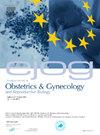Delivery mode and risk of intraventricular hemorrhage: A retrospective single-center study on 1760 preterm infants of less than 32 weeks
IF 2.1
4区 医学
Q2 OBSTETRICS & GYNECOLOGY
European journal of obstetrics, gynecology, and reproductive biology
Pub Date : 2025-02-01
DOI:10.1016/j.ejogrb.2024.12.017
引用次数: 0
Abstract
Objective
To evaluate the association between delivery mode and intraventricular hemorrhage (IVH) in infants with a gestational age (GA) < 32 weeks.
Study Design
We retrospectively reviewed data of 1760 infants with a GA between 24+0/7 and 31+6/7 weeks/days born between 01.01.2004 and 31.12.2022. We excluded outborn, congenital malformations, infants born by complicated delivery and without antenatal corticosteroid administration. Exposure was the delivery mode: cesarean section (CS) versus vaginal delivery (VD). IVH within the first week of life was the primary outcome. Multiple regression analyses were used to evaluate the association between delivery mode and IVH. CS infants were also match-paired for GA and small for gestational age (SGA) with VD infants.
Results
The incidence of IVH was lower in 1046 CS than in 144 VD study infants (IVH I-IV: 14 vs 29 %, p < 0.001; IVH I-II: 10 vs 22 %, p < 0.001; IVH III-IV: 3 vs 8 %, p = 0.008). CS was associated with a lower risk of IVH grades I-IV (aOR: 0.52, p = 0.012) after the adjustment for GA, year of birth, sex, singleton pregnancy, SGA, hypertensive disorders of pregnancy, pH ≤ 7.00 and/or standard base excess (SBE) ≤ -12 mmol/L at cord blood gas analysis, early-onset sepsis, hemodynamically significant patent ductus arteriosus, thrombocytopenia, need of blood transfusion, mechanical ventilation and inotropes/vasoactive amines.
Conclusions
CS was associated with lower risk of IVH than VD in infants with a GA between 24+0/7 and 31+6/7 weeks/days, born by uncomplicated delivery and who have received antenatal corticosteroids.
分娩方式和脑室内出血的风险:一项对1760例32周以下早产儿的回顾性单中心研究。
目的:评估分娩方式与胎龄(GA)婴儿脑室内出血(IVH)的关系。研究设计:我们回顾性分析了2004年1月1日至2022年12月31日出生的1760例胎龄在24+0/7至31+6/7周/天之间的婴儿的数据。我们排除了先天畸形、先天性畸形、复杂分娩和未在产前使用皮质类固醇的婴儿。暴露是分娩方式:剖宫产(CS)和阴道分娩(VD)。出生后第一周内的IVH是主要结果。采用多元回归分析评价分娩方式与IVH的关系。CS婴儿也与VD婴儿匹配GA和小胎龄(SGA)。结果:1046例CS中IVH的发生率低于144例VD研究婴儿(IVH I-IV: 14% vs 29%, p)。结论:在24+0/7周至31+6/7周/天、无并发症分娩出生、产前接受皮质类固醇治疗的GA婴儿中,CS与IVH的风险较VD低相关。
本文章由计算机程序翻译,如有差异,请以英文原文为准。
求助全文
约1分钟内获得全文
求助全文
来源期刊
CiteScore
4.60
自引率
3.80%
发文量
898
审稿时长
8.3 weeks
期刊介绍:
The European Journal of Obstetrics & Gynecology and Reproductive Biology is the leading general clinical journal covering the continent. It publishes peer reviewed original research articles, as well as a wide range of news, book reviews, biographical, historical and educational articles and a lively correspondence section. Fields covered include obstetrics, prenatal diagnosis, maternal-fetal medicine, perinatology, general gynecology, gynecologic oncology, uro-gynecology, reproductive medicine, infertility, reproductive endocrinology, sexual medicine and reproductive ethics. The European Journal of Obstetrics & Gynecology and Reproductive Biology provides a forum for scientific and clinical professional communication in obstetrics and gynecology throughout Europe and the world.

 求助内容:
求助内容: 应助结果提醒方式:
应助结果提醒方式:


